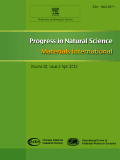
Progress in Natural Science-Materials International
Scope & Guideline
Advancing Materials Science for a Sustainable Future
Introduction
Aims and Scopes
- Materials Synthesis and Characterization:
The journal consistently publishes research on novel synthesis techniques and characterization methods for advanced materials, including nanomaterials, composites, and alloys, highlighting their properties and potential applications. - Energy Storage and Conversion:
A significant focus is on materials for energy applications, particularly lithium-ion batteries, fuel cells, and hydrogen storage solutions, contributing to the advancement of sustainable energy technologies. - Environmental and Waste Management:
Research on the utilization of waste materials and the development of eco-friendly materials for environmental remediation demonstrates the journal's commitment to sustainability and waste management. - Functional Materials Engineering:
The journal covers a wide range of functional materials, including catalysts, sensors, and photonic materials, exploring their engineering and applications in various technological fields. - Metallurgy and Alloys:
A core area includes the study of metallic and alloy materials, focusing on processing techniques, mechanical properties, and performance under various conditions, which is crucial for industrial applications.
Trending and Emerging
- Nanomaterials and Nanocomposites:
There is a growing emphasis on the development and application of nanomaterials and nanocomposites due to their unique properties and potential uses in various high-tech applications. - Sustainable and Green Materials:
Research focusing on sustainable materials, including biodegradable polymers and materials derived from waste, is increasingly prominent, aligning with global sustainability goals. - Advanced Energy Materials:
Emerging themes include the development of advanced materials for energy storage and conversion technologies, particularly in the context of renewable energy solutions and battery technology. - Smart and Functional Coatings:
There is a notable increase in studies on smart materials and functional coatings that respond to environmental stimuli, indicating a trend towards multifunctional materials. - Additive Manufacturing and 3D Printing:
Research related to additive manufacturing techniques and their applications in materials science is on the rise, reflecting the growing interest in innovative fabrication methods.
Declining or Waning
- Traditional Ceramic Materials:
Research on conventional ceramic materials appears to be decreasing, possibly due to the emergence of more advanced materials and composites that offer enhanced properties and functionalities. - Basic Theoretical Studies:
Papers focusing solely on theoretical models without experimental validation are less frequent, suggesting a shift towards more applied research that demonstrates practical applications of materials. - Biomaterials for Medical Applications:
Although still relevant, the frequency of publications on biomaterials specifically for medical applications has diminished, possibly due to the rise of interdisciplinary studies integrating biomaterials with other fields. - Conventional Polymers:
Research on standard polymers without innovative modifications or applications is waning, as the focus shifts towards advanced polymer composites and smart materials with enhanced properties. - Niche Applications of Materials:
Studies targeting niche applications in materials science have decreased, indicating a trend towards broader applications that have more significant industrial and technological implications.
Similar Journals

Sustainable Materials and Technologies
Exploring Innovative Paths to Material SustainabilitySustainable Materials and Technologies is an esteemed journal published by Elsevier, focusing on pioneering research and innovative solutions in the fields of industrial engineering, materials science, and environmental sustainability. With a prestigious Q1 ranking in multiple relevant categories—including Industrial and Manufacturing Engineering, Materials Science, Renewable Energy, Sustainability, and Waste Management—this journal is positioned as a leading platform for disseminating high-impact research that addresses pressing challenges in material sustainability. Recognized for its rigorous peer-review process and commitment to academic excellence, Sustainable Materials and Technologies is dedicated to providing open access to groundbreaking studies and practical methodologies that drive forward the agenda for a sustainable future. Since its inception in 2014, the journal has been integral for professionals, researchers, and students who are engaged in the quest for innovative materials and technologies that minimize ecological footprints. Join a community at the forefront of sustainability science by contributing to and engaging with the transformative research published in this pivotal journal.
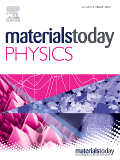
Materials Today Physics
Driving Progress in Interdisciplinary Materials ResearchMaterials Today Physics, published by Elsevier, is a prestigious journal that focuses on the interdisciplinary field of materials science, physics, and energy innovations. With an impressive impact factor and a Q1 ranking in three categories—Energy (miscellaneous), Materials Science (miscellaneous), and Physics and Astronomy (miscellaneous)—it stands out as a key platform for disseminating high-quality research. The journal, which has been in circulation since 2017, provides a vital resource for academics and industry professionals alike, facilitating the exchange of knowledge and driving advancements in materials research. Available in both traditional and open-access formats, Materials Today Physics aims to publish cutting-edge research articles that push the boundaries of material properties and their applications, thereby contributing to the development of sustainable technologies and energy solutions. With a commitment to excellence, this journal offers a robust avenue for researchers to share their findings with a global audience, making it an essential tool for those engaged in the rapidly evolving fields of physics and materials science.

Materials Chemistry Frontiers
Exploring the Future of Materials ScienceMaterials Chemistry Frontiers, published by the esteemed Royal Society of Chemistry, stands as a leading journal in the realm of materials science and chemistry, with an impressive Q1 ranking in both Materials Chemistry and Materials Science categories as of 2023. This open-access journal, operating from the United Kingdom, offers a platform for researchers, professionals, and students to disseminate high-quality, impactful research. With its E-ISSN 2052-1537, the journal is dedicated to publishing cutting-edge articles, reviews, and research communications that explore innovative materials and their applications, fostering a comprehensive understanding of the complex interplay between materials and their chemical properties. With consistent rankings in the Scopus metrics, being positioned at the 25th percentile among 317 in the Materials Chemistry category, it highlights its pivotal role in advancing the field. The journal thrives on contributions that broaden the scope of knowledge from 2017 to 2024 and beyond, solidifying its status as an essential resource for contemporary research in materials science.
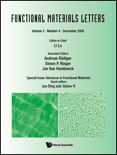
Functional Materials Letters
Connecting scholars in the realm of functional materials.Functional Materials Letters, published by World Scientific Publishing Co. Pte Ltd, is an esteemed academic journal dedicated to disseminating cutting-edge research in the field of materials science. Since its inception in 2008, the journal has provided a vital platform for researchers, professionals, and students to share their discoveries pertaining to functional materials, which are integral for diverse applications ranging from electronics to advanced manufacturing. With an ISSN of 1793-6047 and an E-ISSN of 1793-7213, the journal operates out of Singapore and maintains a notable presence in the global academic community, currently ranked in the Q3 quartile for materials science. Although it does not offer open access, the journal ensures that its publications are rigorously peer-reviewed, contributing significantly to the advancement of knowledge in this rapidly evolving field. Researchers aiming to stay at the forefront of materials science will find Functional Materials Letters an indispensable resource that highlights innovative findings and fosters collaboration among scholars.

Materials Today Advances
Elevating research visibility in cutting-edge materials science.Materials Today Advances is a premier open access journal, published by Elsevier, dedicated to disseminating cutting-edge research in the fields of Materials Science and Mechanical Engineering. Since its inception in 2019, the journal has quickly established itself within the academic community, achieving an impressive Q1 quartile ranking in both disciplines as of 2023, indicative of its high-impact contributions. Ranked #25 out of 672 in Mechanical Engineering and #46 out of 463 in General Materials Science according to Scopus, Materials Today Advances offers rigorous peer-reviewed articles that address the latest innovations and interdisciplinary approaches. Researchers, professionals, and students can benefit from the journal's open access model, ensuring widespread visibility and accessibility of groundbreaking findings. With the convergence of advanced materials research and practical applications, this journal represents a vital resource for those at the forefront of scientific discovery.
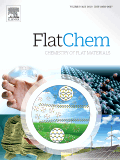
FlatChem
Fostering Global Collaboration in Materials InnovationFlatChem, an esteemed journal published by ELSEVIER, serves as a premier platform for disseminating high-quality research in the dynamic fields of ceramic and composite materials, electronic and optical materials, materials chemistry, and surfaces, coatings, and films. Since its inception in 2017, the journal has garnered a robust reputation, evidenced by its rank in the top quartile (Q1) across multiple categories, including a commendable rank of #25/127 in Ceramics and Composites and #49/284 in Electronic, Optical and Magnetic Materials. With a focus on pioneering advancements and innovative methodologies, FlatChem not only highlights cutting-edge research but also promotes collaboration and knowledge exchange within the scientific community. The journal’s impact is underscored by its impressive rankings in Scopus, marking it as a vital resource for researchers, professionals, and students aiming to stay at the forefront of materials science. As an open-access journal, it ensures that groundbreaking findings are readily accessible, fostering a broader understanding and application of materials innovation worldwide. The journal is based in the Netherlands, with its headquarters located at RADARWEG 29, 1043 NX AMSTERDAM, NETHERLANDS. Join the vibrant community contributing to FlatChem and engage with the forefront of material advancements.

ADVANCED FUNCTIONAL MATERIALS
Bridging Theory and Application in Functional MaterialsADVANCED FUNCTIONAL MATERIALS is a leading journal published by WILEY-V C H VERLAG GMBH, prominently recognized in the fields of biomaterials, chemistry, condensed matter physics, and materials science. With an impressive impact factor and a distinguished position in the Q1 quartile across multiple categories including nanoscience and nanotechnology, this journal serves as a vital platform for researchers and professionals committed to innovating in functional materials. Since its inception in 2000, ADVANCED FUNCTIONAL MATERIALS has published high-quality peer-reviewed articles that push the boundaries of materials science, exploring new frontiers in electronic, optical, and magnetic materials. The journal's dedication to open access ensures that its groundbreaking findings are readily available to a global audience, fostering collaboration and knowledge-sharing among scholars and practitioners in the field. For those seeking to stay at the forefront of materials research, ADVANCED FUNCTIONAL MATERIALS is an essential resource.

BULLETIN OF MATERIALS SCIENCE
Unveiling Breakthroughs in Material DevelopmentBulletin of Materials Science, published by the Indian Academy of Sciences, is a distinguished journal that has been contributing to the field of materials science since its inception in 1979. With an ISSN of 0250-4707 and E-ISSN 0973-7669, it provides a platform for researchers to share groundbreaking studies and advancements in the mechanics of materials and general materials science. As of 2023, the journal holds a respectable Q3 ranking in both the Materials Science (miscellaneous) and Mechanics of Materials categories, highlighting its competitive position in the academic landscape. Although the journal currently does not operate under an open access model, it remains a vital resource for professionals and students keen on exploring innovative material developments and methodologies. With a commitment to promoting high-quality research, the Bulletin of Materials Science features rigorous peer-review processes, making it an essential reference for anyone engaged in the materials science domain.
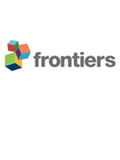
Frontiers in Materials
Pioneering Transformative Applications in Materials Science.Frontiers in Materials, an esteemed journal published by FRONTIERS MEDIA SA, is a leading platform in the field of Materials Science, with a notable impact factor placing it in the Q2 category of its discipline as of 2023. Since its establishment as an Open Access journal in 2014, it has fostered considerable academic exchange, allowing researchers from around the globe to share their innovative findings and insights. Based in Lausanne, Switzerland, this journal not only emphasizes high-quality peer-reviewed articles but also prioritizes rapid dissemination of research, as evidenced by its commendable Scopus ranking of #62 out of 196 in Materials Science (miscellaneous). By consistently striving to bridge the gap between academia and practical applications, Frontiers in Materials serves as an invaluable resource for researchers, professionals, and students seeking to delve into cutting-edge advancements and transformative applications in materials science.
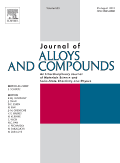
Journal of Alloys and Compounds
Innovating the Future of Alloys and CompoundsJournal of Alloys and Compounds, published by Elsevier Science SA, stands at the forefront of materials research, focusing on the properties, applications, and innovations within alloys and compounds. With an impressive impact factor and prestigious rankings placing it in the Q1 quartile across multiple related categories—including Materials Chemistry, Mechanical Engineering, and Mechanics of Materials—this journal is recognized for its significant contributions to the field. Researchers and professionals engaged in metallurgy, materials science, and engineering will find it a critical resource that encompasses groundbreaking studies, insightful reviews, and essential findings. The journal has a strong influence, as evidenced by its Scopus rankings—ranking 14th in Metals and Alloys and 28th in Mechanics of Materials, indicating a robust global impact. As it continues to publish cutting-edge research from 1991 to 2024, the Journal of Alloys and Compounds serves as a vital platform for the exchange of knowledge, thereby advancing our understanding of complex materials and fostering innovation in diverse applications.